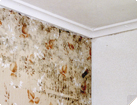Health and Safety
Taking care with materials, equipment and work procedures and dealing with hazards.
Mould
Moulds are fungi that can grow on almost any surface where moisture is present. They reproduce by releasing vast numbers of tiny spores into the air. There is no effective way of eliminating mould, but it can be controlled by ensuring houses are weathertight, warm and well ventilated to reduce excess indoor moisture levels.
If inhaled in large quantities, some mould spores can cause health problems such as allergic reactions similar to hay fever, breathing difficulties, eye irritation, skin rashes and occasionally, more serious symptoms.
On this page
- mould, moisture and ventilation
- Stachybotrys chartarum (SC)
- testing for Stachybotrys.
- removing and cleaning up procedures for moulds.
Mould, moisture and ventilation
Mould growth can often be seen as surface discolouration on ceilings, walls and furniture. There may also be a musty smell. If there is any evidence of water damage, there is likely to be mould growth.
Visible mould in houses is typically the result of high levels of indoor moisture and insufficient ventilation and/or heating. The best solutions are to install a rangehood over the stove in the kitchen and an exhaust fan in the bathroom. Both should be vented to the outside. Building occupants should be encouraged to increase ventilation through opening windows, to keep the space warm, and to avoid using unflued gas heaters, which produce a lot of moisture.
Removal and clean-up for non-toxic moulds
The moulds most commonly seen on surfaces around the house are generally not toxic. To remove them, wash the surface with warm water and household detergent, using a cloth or scrubbing brush depending on the surface. Rinse with clean water and allow the surface to dry thoroughly.
If you wish you can then disinfect or sanitise the surface by repeated treatments with methylated spirits, but ensure the area is well ventilated.
Mould may be removed from fabrics by washing.
Stachybotrys chartarum
Some types of moulds produce toxic compounds. Stachybotrys chartarum is a toxic mould that is associated with leaking buildings in New Zealand. The mould is caused by leaks that originate outside the building and from leaks within wet areas in buildings.
Stachybotrys is a greenish-black mould that grows on materials that contain cellulose such as wood fibreboard, fibre-cement, the paper lining of gypsum board, kraft paper wall and roof underlays, wallpaper and timber, when the material is subject to wetting. Census 2018 data shows that 29% of homes heated only by portable gas heaters have mould problems.
Finding Stachybotrys in a building does not immediately mean that the building occupants have been exposed to allergens or toxins. While Stachybotrys is growing, a wet slime covers the spores, preventing them from becoming airborne. Exposure will only occur when the mould has died and dried up.
If you are working where Stachybotrys is suspected, investigate from outside, if possible, by removing a small portion of lining to determine the type of mould present.
Testing for Stachybotrys
If any black mould is found, it is recommended that it be tested to determine if it is Stachybotrys chartarum. Carefully take a sample by the following process:
- 1. Work with a mask or breathing filter and disposable gloves.
- 2. Ensure that no skin is exposed.
- 3. Place a strip of clear adhesive tape over the mould and press firmly. Around 100 mm will be long enough – the important thing is to make sure that what is being sampled by the tape is representative of the discolouration on the building material surface.
- 4. Remove the tape and place onto non-stick baking paper. Fold the paper around the tape and place in a plastic bag.
- 5. Securely seal the bag.
- 6. Send the sample to a testing laboratory such as Biodet Services Ltd (www.biodet.co.nz), Airlab Ltd (www.airlab.co.nz) or Plant Diagnostics (www.plantdiagnostics.co.nz).
Building material samples affected by mould (plasterboard, carpet etc.) can also be submitted for testing if this is possible and the property owner provides their permission for this more invasive testing.
Removing and cleaning up procedures for toxic moulds
When toxic mould is found, it usually affects a significant area of the building and employing a specialist contractor to carry out the removal is recommended. Where wall cavities have been opened up and mould is found, it is recommended that the wall cavity be sealed until remediation can take place.
Updated: 04 July 2023


